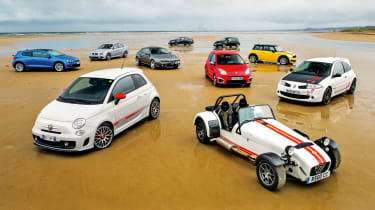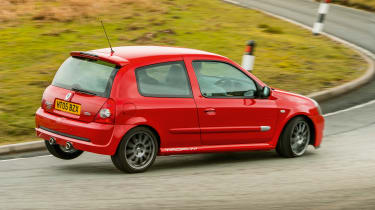Where have all the affordable driver's cars gone?
Affordable performance cars seem to be a dying breed. We look back at a recent golden age – and highlight where cheap thrills can still be found, new and second-hand
Time for a trip down memory lane. Not several decades back, to witness Group B rallying in its pomp or the rise of the ’70s supercar wedge. Nope, we’re more modestly rewinding 14 years. You join me for a plodge across Porthmadog Beach at the start of eCoty 2008. There’s no six-figure exotica to be seen, for this is the first leg, where a bunch of real-world contenders are being whittled down to one cut-price hero that’ll attempt to embarrass a 997 GT2 and Nissan GT‑R in southern France. Oh, and unleaded is less than a quid a litre. Happy days.
The cast is strong. There’s a sub-£50k BMW M3 with a proper gearstick in the middle and a Lexus IS F to give it a decent scrap. We’ve two brand new Renault Sports, neither wearing a Clio badge just to prove the breadth of the firm’s hot hatchback range. Nearby is an Impreza special with 325bhp, like it’s still the really early days of evo, not to mention a delectable little Alfa Romeo coupe with a Prodrive chassis alongside the recently relaunched VW Scirocco. The real world looks awfully fun indeed.
> Cheap fast cars 2023 – the best budget performance cars on the market
Especially in the context of 2023’s performance car landscape. Now that the M3 has soared into luxury car territory and Renault Sport production has ceased entirely, none of those aforementioned cars exist in today’s market. Only the Mini JCW, Caterham R500 and Abarth 500 have soldiered on from that autumn 2008 shoot, albeit in slightly different forms. Quick Minis haven’t fully grabbed our attention for a while now and while Abarth’s commitment to stiffly sprung Fiats with overwrought names deserves a hearty salute, we can’t imagine buying one new. We still adore a quick Seven, but true attainability evades it on account of a Caterham surely only ever being a second (or third) car.
A visit to sodden Welsh climes might seem like a misuse of your time machine token, but if you’re looking for a vignette of the decline of the affordable performance car, that sandy group shot could be it. A huge financial crash lay just around the corner, for starters. Almost at the exact moment Stuart Collins was collapsing his tripod, Lehman Brothers collapsed too, the car industry soon feeling the aftershocks as manufacturers pulled the plug on less profitable projects.
Perhaps the following ‘credit crunch’ can be blamed for Renault selling barely half its UK allocation of the car that headed victoriously from Welsh mountains to French ones, the mighty Mégane R26.R. Its now bafflingly modest £23,815 RRP simply wasn’t something us Brits wanted to swap for a two-seat hatchback with plastic rear windows. Luckily the folks in Dieppe ignored our idiocy and created two further, yet more extreme iterations of the same idea. The brand, though, has since been swallowed by Alpine, who’ll soon be electric-only.
Renault ditching hot hatches ought not to have been a surprise, given that Citroën and Peugeot had recently followed similar paths. The dinky little Twingo 133 Cup from eCoty 2008 was replaced by a lame and short-lived Twingo GT, the formerly heroic Clio departed with a hint of ignominy when it went paddleshift-only, while the Mégane only recently left showrooms, its head held a little higher in retirement than its smaller siblings but with any future version sourcing its power only from a socket.
Happily, Hyundai’s fledgling N division has demonstrated rich form so far, the i30 N channelling a lot of the old Mégane’s gnarly character, just with a bit more interior vim and a longer warranty. There’s more than a hint of the 2009 Clio 200 Cup in the littler i20 N, too, the pair sharing spookily similar power, weight and dimensions. Both provide good news stories in our little corner of the world, but there’s just no escaping that N’s future intent is also zero tailpipe emissions.
> Best cars to buy for £10,000 – evo garage
You’d be forgiven if the little Twingo had left your memory bank entirely, but it offers a particularly interesting snapshot in time, not least because it had its own, rather curious convertible spin-off in the shape of the Renault Wind. Not to mention Gordini versions with plusher interior trim to take on the dynamically inferior but more arresting Abarth 500. What now feels alien is just what a wealth of rivals this car had, with two evo group tests (issues 132 and 167) seeing a seven-strong supermini contingent battle it out. The Fiat Panda 100HP was among the stars first time around, and these remain a hilarious bargain (starting at around £2.5k) if you can buy with a stroke of luck and avoid some typically Italian maintenance bills. The second test saw the second-gen Suzuki Swift Sport narrowly edge the now slightly ageing Twingo; while the Sport remains on sale, it does so only in severely neutered and oddly expensive Hybrid form, Suzuki’s need to market an all-electrified range robbing a once fabulously simple hot hatchback of its honesty. By the time Volkswagen finally made an Up GTI, there wasn’t much for it to be beat.
The Swift’s unexpected costume change segues us to another of the reasons the affordable performance car is struggling to keep its head above water: fleet CO2 targets. Manufacturers selling cars in Europe simply have to act to avoid crippling fines, and Nissan’s refusal to bring its latest Z-car here is the tip of one iceberg proving resilient to climate change. Car makers must limit the quantity of quicker, higher-polluting models they bring here, or refuse us model lines entirely. This issue has coincided with the recent chip shortages that have so skewed the course of the new car market, and one of the great evo icons of recent years sits right amidst the maelstrom.
The Ford Fiesta ST has just received a minor facelift, the big headline being that it’s now five-door only. We won’t lose too much sleep over that; it’s sad that hot hatches have been losing their muscular little bodyshells and bespoke design language – Ian Callum penned the Escort Cosworth, don’t forget – but it’s easy to see how slicing this portion of their development costs is a bit of a no-brainer for the manufacturer. What’s more notable is that Ford has reprioritised its production in an ongoing parts shortage and directed the majority of its resources at the Puma, Kuga and Mustang Mach-E. SUVs, in other words. The ST remains terrific; a slick little six-speed manual is your only gearbox option, and a truly rapscallion character courses through the chassis. It’s just now outsold by something a little heavier. And whatever you think of crossovers, Ford has done an admirable job of distilling the Fiesta’s character into the Puma ST, with even more comic lift-off oversteer possible with its higher, more pronounced centre of gravity.
Yep, we’ve stumbled across another of the nails in the small, cheap sports car coffin. The performance SUV was still in its infancy back in autumn 2008. ‘Come on, what’s the point?’ we said as the ginormous BMW X6, Audi Q7 and Porsche Cayenne all claimed joint honours in the acerbic Not Car of the Year awards. ‘These two-ton-plus edifices have allowed a few chassis engineers to prove how smart they are but, now more than ever, the role of these over-powered bully boys’ “cars” appears to be to give future generations something to mock.’ And yet they’ve kept coming, with even Alpine about to give in to the trend. While the Puma ST is a long way from the OTT power, weight and general willy-waving of peak SUV, the metamorphosis of the Puma nameplate is something we have to observe when lamenting the changing performance car market. When evo launched, the original Puma was right at the heart of the cars it championed. And owned, during its first few years of publication.
Another Callum design, it had a whiff of DB7 and matched a unique Yamaha 1.7-litre that adored revs with mischievous handling and a cool ad campaign. Were it not for the fact that its rear arches dissolve like candyfloss in water, the original Puma might be a perfect car. Which is probably why there was some consternation when the name was recycled in 2019 for a podgy little SUV that belatedly joined the Nissan Juke class, albeit with typically smart Ford dynamics and a boot floor that swallows an absurd amount of beer. The fact that the new-school Puma’s sales outstripped the original’s little over a year into its life only vindicated the decision to move the badge onto a more zeitgeisty model. If you really want to feel mournful, then know that the Mazda CX‑5 crossover clocked a million sales in a mite over three years when the MX‑5 took a quarter of a century to do the same…
Japan’s been a fine source of affordable icons over the decades, of course – the first few years of evo were awash with increasingly suffix-laden Imprezas and Lancers – and none has proved more resilient than the MX‑5. I can’t really add anything to the likely hundreds of thousands of words this magazine has published on the car since 1998; perhaps most telling is just how many rivals have waved the white flag after attempting to match it, the Abarth and Fiat 124 Spiders – built in Mazda’s Hiroshima factory on the same platform, and now used bargains (£15k gets you in one) – among the more intriguing attempts to apply CPR to the cheap roadster market.
The Honda S2000 and Mazda RX‑8 both left our market not long after the Lehmann Brothers crash, both without replacement, though it might be a stretch to say we truly miss either car more than the ethos it represented. Flamboyant over-engineering and esoteric powertrains have arguably been both a gift and curse of Japanese performance cars at all price points and the MX‑5’s joyous simplicity is surely the secret to its 30-plus-year life. That same simplicity also courses through the Toyota GT86 – yours for sub-£10k – and its fabulous GR86 replacement, though the latter’s life will be puzzlingly short owing to impending crash structure regulations that its low-slung bonnet isn’t allowed to limbo under. Shame.
We’ve the GR Yaris to dry our tears, of course, and there’s no doubt it’s a minor hero all of its own, the latest in a long line of £30k/£300 a month hot hatches that the British buying public can’t get enough of. The F20-gen BMW M135i, Mk7 Golf R and Mk3 Focus RS all launched at similarly tantalising prices and larger, more complex breeds of hot hatchback remain pretty strong in population – albeit with hybridisation and crossover spin-offs nibbling away at their purity. At least the latest FL5 Honda Civic Type R is happily digging in its heels with its expensive bespoke bodywork, manual-only transmission and a flagrant lack of electrification. The last of its breed? Almost certainly, and we should lap it up while we can. Not least because it’s the spiritual successor to one of the evo greats.
Just about any ‘greatest driver’s car’ list we’ve ever compiled has contained surely the two greatest affordable performance cars of all time, a pair that’s inevitably rising in stock on the second-hand market. The Honda Integra Type R and Renault Sport Clio 182 Trophy have graced numerous covers, the latter most famously under the line ‘Giant Killer’. You can still (just about) get an example of either for ten grand, but you can easily pay three times as much with a twitchy auction hand.
Look elsewhere and there are still bargains to be had. Twingos and Swifts can be bought for under £5000 if you want something with a touch of the disposable about it. You’ll pay the same for a well looked-after Puma, significantly less for something rust-bitten. Just keep the number of a friendly welder handy. The MX‑5 is a stalwart of the used car scene, with able tuners like BBR ready and willing to dramatically up your car’s power and focus if you want something to keep more modern machinery honest on a local track evening. The Mégane R26.R hasn’t yet truly soared to icon money – though it’s headed there – while as little as £10,000 can secure you an example of Renault’s brilliant follow-up act, the Mégane 250 Cup. Or one of its seemingly infinite updates.
If you’d prefer one of the subtler heroes of that mighty eCoty 2008 line-up, a V8 M3 still sneaks under £20,000 if you’re feeling especially brave and reckon a really attainable performance car still needs to ably serve family duties. The number of brand-new real-world sports cars may appear to be shrinking, but there’s still plenty of opportunity to immerse yourself in the genre’s wonderfully rich recent past.
This story was first featured in evo issue 302.







